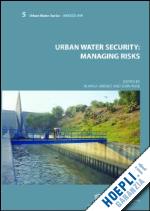1Introduction 2Drinking water – Potential health effects caused by wastewater disposal2.1Introduction2.2Direct and indirect wastewater reuse2.3Microbiological risks2.3.1Viruses2.3.2Bacteria2.3.3Protozoa2.3.4Helminths2.4Risk reduction of pathogens in drinking water2.5Chemical risks2.6Treated wastewater in surface waters2.7The occurrence of pharmaceuticals in drinking water2.8Risk management of microbial and chemical hazards2.9Implementation of Water Safety Plans2.10HACCP2.11Hazard analysis2.12Conclusions2.13References 3Microbial Health Risks and Water Quality3.1Introduction3.2The Traditional Icons of Waterborne Disease3.2.1Cholera3.2.2Typhoid3.2.3Hepatitis3.2.4Generic Diarrhea3.3Emerging Diseases and Zoonotic Pathogens3.3.1Cryptosporidium3.3.2Cyclospora3.3.3E. coli O157:H73.3.4Helicobacter3.4Risk Assessment and Control of Waterborne Pathogens3.4.1Use of Quantitative Microbial Risk Assessment3.4.2Interventions to reduce enteric diseases3.4.3Vaccinations3.5Conclusions and Recommendations3.6References 4Chemical Health Risks4.1Introduction4.2Human Health Risks4.2.1An Overview on Exposure Factors4.2.2Human Exposure in Urban Water Cycle4.3Risk Sources and Risk Compounds in Urban Water Cycle4.3.1Releases to Water4.3.2Chemical Compounds4.4Inorganic Chemical Risk Agents: Sources and Human Health Diseases of Concern4.4.1Nitrates and Nitrites4.4.2Fluoride4.4.3Toxic Metals4.4.3.1Arsenic4.4.3.2Mercury4.4.3.3Lead4.5Organic Chemical Risk Agents: Sources and Human Health Diseases of Concern4.5.1Hydrocarbons Compounds4.5.2Chlorinated Organic Compounds4.5.2.1Volatile Organic Compounds (VOCs)4.5.2.2Solvents4.5.2.3Trihalomethanes (THMs)4.5.3Pesticides4.5.4Persistent Organic Pollutants (POPs)4.5.5New Chemicals4.6Chemical Risks in Urban Cities in Developed Countries4.6.1Fluoride4.6.1.1China4.6.1.2Japan4.6.1.3United States of America4.6.2Arsenic (As)4.6.2.1Canada4.6.2.2China4.6.2.3United States of America4.6.3Mercury4.6.3.1Canada Arctic4.6.3.2China4.6.3.3Japan4.6.3.4United States of America4.6.4Volatile Organic Compounds (VOCs)4.6.4.1Netherlands4.6.4.2United States of America4.6.5Trihalomethanes (THMs)4.6.5.1Alaska4.6.5.2Canada4.6.5.3United Kingdom4.6.5.4United States of America4.6.6New Chemicals4.7Chemical Risks in Urban Cities in Developing Countries4.7.1Fluoride4.7.1.1Brazil4.7.1.2Ethiopia4.7.1.3India4.7.1.4Kenya4.7.1.5Mexico4.7.1.6Saudi Arabia4.7.1.7South Africa4.7.1.8Turkey4.7.1.9United Republic of Tanzania4.7.2Arsenic (As)4.7.2.1Argentina4.7.2.2Bangladesh – West Bengal, India4.7.2.3Chile4.7.2.4Mexico4.7.2.5Taiwan4.7.2.6Thailand4.7.2.7Vietnam4.7.3Mercury (Hg)4.7.3.1Brazil4.7.3.2Philippines4.7.3.3South Africa4.7.4Trihalomethanes (THMs)4.7.4.1Greece4.7.4.2Malaysia4.7.4.3Mexico4.7.4.4Turkey4.7.5Pesticides4.7.5.1Brazil4.7.5.2Egypt4.7.5.3South Africa4.8Chemical Risk Management in Urban Water Cycle4.8.1Chemical Risks Identification in Urban Water Cycle4.8.1.1Drinking water4.8.1.2Other water-related chemical risks4.8.2Vulnerability and Variability4.8.3Urban Water Policy4.9References 5Risk Management on the urban water cycle. Climate change risks5.1Introduction5.1.1Global climate change5.1.2Global climate change and hydrological cycle5.1.3Mitigation of GHG emissions5.2Water in an urbanized world5.2.1Water scarcity5.3Impacts and risks5.3.1Water availability and glacial melt5.3.2Sea level rise and extreme events5.3.3Water quality5.3.4Changes in the past decades related to Global Climate Change5.3.5Risks for urban settlements5.4Adaptation and integration of climate change into urban water resource management5.4.1Adaptation and sustainable development5.4.2Planning under uncertainties5.4.3Supply and demand options5.4.4Urban water management5.4.5Poverty and equity5.4.6International aid5.5Conclusions5.6References 6Water source and drinking water risk management6.1Introduction6.2Security, Reliability and Risk6.3Uncertainty, Threats and Effects6.4Prevention, Mitigation and Resolution6.5Scarcity and Drought, an Operational Example6.6Conclusions and Recommendations 7Wastewater risks in the urban water cycle7.1Introduction7.2Pollutants sources7.2.1Point sources7.2.1.1Municipal wastewater7.2.1.2Industrial wastewater7.2.1.3Stormwater7.2.2Non point pollutant sources7.2.2.1Urban infrastructure7.2.2.2Urban activities7.2.2.3Disposal practices7.2.2.4Other sources7.3Pollutants involved7.3.1Conventional parameters7.3.2Biological pollutants7.3.3Emerging pollutants7.3.3.1Content in water7.3.3.2Content in surface and groundwater7.4Management7.4.1Changing the concept of pollution sources7.4.2Gathering useful information7.4.3Monitoring campaigns7.4.4Water Sources management7.4.4.1Groundwater7.4.4.2Surface water7.4.5Pollutant management7.4.5.1Biological pollutants7.4.5.2Chemical compounds7.4.6Urban infrastructure and urban activities7.4.7Climate change7.4.8Education and research7.5Treatment7.5.1Biological pollutants7.5.2Emerging pollutants7.5.3Criteria for selecting wastewater treatment processes7.6Wastewater disposal7.6.1Soil disposal7.6.1.1Soil disposal and aquifer storage7.6.1.2Soil disposal and agriculture7.6.2Disposal in water bodies7.6.2.1Eutrophication7.6.2.2Coupling wastewater disposal with water reuse7.7Conclusions7.8References 8Risks Associated with Biosolids Reuse in Agriculture8.1Introduction8.2Nutrient and agronomic value8.3Microbiological quality8.4Potentially toxic elements8.5Organic contaminants8.6Conclusions8.7References 9“Closing the Urban Water Cycle” Integrated Approach towards Water Reuse in Windhoek, Namibia9.1Introduction9.2Water sources in Windhoek9.2.1Conventional water sources9.3Reuse Options Implemented in Windhoek9.4Future water supply augmentation to Windhoek9.5Various process modifications from 1968 to 19959.6Process design for the new Goreangab water reclamation plant9.6.1Summary9.6.2Raw Water Quality Profile9.6.3Determination of Treatment Objectives9.6.4The Multiple-Barrier Concept9.6.5Experiments and Pilot Studies to Determine Process Design Criteria9.7Selection of Final Process Train9.8Operational Experience to Date9.9Water Quality and Monitoring9.10Quality concerns with the present process configuration9.11Cost Considerations9.12Public Acceptance of Direct Potable Reuse9.13New Research and Development Options9.14Conclusion9.15References 10Reducing risk from wastewater use in urban farming – a case study of Accra, Ghana10.1Introduction10.2The case of Accra10.2.1Urban water use and wastewater management10.2.2Irrigated urban vegetable farming10.2.3Irrigation water quality10.2.4Quality of vegetables in urban markets in Accra10.2.5Numbers of consumers at risks10.2.6Risk Assessment to farmers and consumers10.3Risk reduction measures10.3.1Explore alternative farmland, tenure security and safer water sources10.3.2Promote safer irrigation methods10.3.3Influence the choice of crops grown10.3.4Avoid post-harvest contamination10.3.5Assist post-harvest decontamination10.3.6Improve institutional coordination to develop integrated policies10.4Conclusions10.5References 11Drinking water – potential health effects caused by infiltration of pollutants from solid waste landfills11.1Introduction11.2Pollutants in landfill leachates11.3The exposure pathways and mechanisms11.4Cases11.5Conclusions11.6References 12Exploding sewers: the industrial use and abuse of municipal sewers, and reducing the risk—the experience of Louisville, Kentucky US12.1Introduction12.2The Hexa-Octa Incident12.3The sewer explosions12.4Industrial waste and hazardous spills12.5About the Louisville and Jefferson County Metropolitan Sewer District (MSD)12.6Reasons for doing permitting and pretreatment compliance programs12.7Components of the Permitting and Pretreatment Compliance Program12.7.1Commercial/industrial process plan review12.7.2Permits12.7.3Unusual Discharge Requests (UDR)12.7.4Industrial inspections12.7.5Sampling and monitoring12.7.6Compliance and enforcement12.8Chemical Spill Prevention and Response—The Hazardous Materials Incident Response Team12.9Sampling and Monitoring to reduce risk—the Collection Syste











